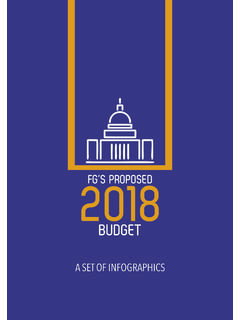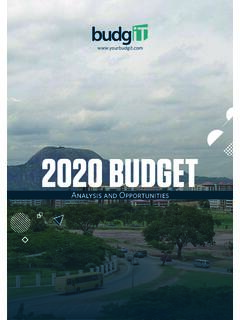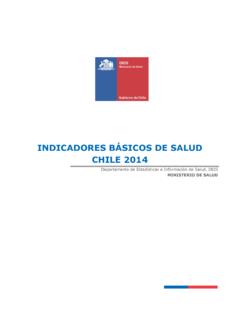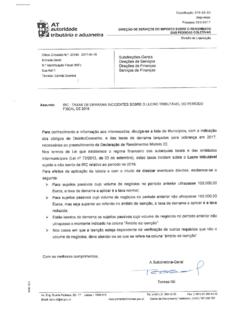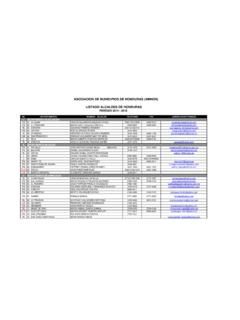Transcription of ECONOMIC RECOVERY GROWTH PLAN
1 1 FEDERAL REPUBLIC OF NIGERIA ECONOMIC RECOVERY & GROWTH PLAN 2017-2020 Ministry of Budget & National Planning FEBRUARY, 2017 2 CONTENTS GLOSSARY .. 5 LIST OF FIGURES, TABLES AND BOXES .. 8 EXECUTIVE SUMMARY .. 10 Introduction .. 10 ERGP s New Approach .. 10 Broad Objectives of the Plan .. 12 Macroeconomic Framework .. 16 Outlook for the Plan .. 19 1 INTRODUCTION .. 21 Rationale for the ECONOMIC RECOVERY and GROWTH Plan .. 22 Governing Principles of the ERGP .. 25 ERGP s New Approach .. 26 The Vision and Strategic Objectives of the ERGP .. 27 2 RESTORING GROWTH MACROECONOMIC STABILITY .. 33 Macroeconomic Objectives .. 33 Macroeconomic Framework.
2 34 The Real Sector .. 37 Fiscal 40 Monetary Policy .. 47 External sector .. 49 3 RESTORING GROWTH ECONOMIC DIVERSIFICATION .. 52 Six priority sectors .. 54 GROWTH policy enablers .. 70 4 BUILDING A COMPETITIVE ECONOMY .. 73 Infrastructure .. 73 Business environment .. 80 5 INVESTING IN OUR PEOPLE .. 84 Healthcare .. 85 Education .. 87 Social inclusion .. 90 Job creation And youth empowerment .. 92 Population GROWTH 95 Environmental sustainability .. 95 3 6 GOVERNANCE .. 97 Transparency and anti-corruption ..97 Public Safety and Security .. 99 Public service reform .. 101 Sub-national coordination ..103 7 DELIVERY.
3 106 Focus on priorities .. 106 Establish clear accountability .. 107 Set Targets and develop detailed action plans .. 107 MOBILISE AND ALLOCATE RESOURCES to priorities .. 108 Create an enabling policy and regulatory environment .. 108 Monitor and drive progress .. 108 CommunicatION .. 109 8 OUTLOOK FOR THE PLAN .. 111 Downside risks .. 112 APPENDIX .. 113 Programme Fiscal stability .. 113 Programme Monetary stability .. 116 Programme External balance .. 117 Programme Agriculture .. 117 Programme Manufacturing .. 119 Programme Solid Minerals .. 121 Programme Services .. 122 Programme Construction .. 123 Programme Oil and Gas.
4 124 Programme Cross-Sector strategies .. 125 Programme Power .. 127 Programme Transport 128 Programme Ease of doing business .. 129 Programme Health .. 131 Programme Education .. 132 Programme Social inclusion .. 133 Programme Job creation AND YOUTH EMPOWERMENT .. 134 Programme Population GROWTH management .. 135 Programme Environmental protection .. 136 Programme Anti-corruption and transparency .. 136 4 Programme PUBLIC SAFETY AND Security .. 137 Programme Public service reform .. 139 Programme Sub-national coordination .. 140 Programme Delivery .. 140 5 GLOSSARY BoA Bank of Agriculture BPO Business Process Outsourcing BRICS Brazil, Russia, India, China.
5 South Africa CACS Commercial Agriculture Credit Scheme CAPEX Capital expenditure CBN Central Bank of Nigeria CNG Compressed Natural Gas DBN Development Bank of Nigeria Disco Electricity Distribution Company EEG Export Expansion Grant EFCC ECONOMIC and Financial Crimes Commission ELPS Escravos Lagos Pipeline System EMT ECONOMIC Management Team ERGP ECONOMIC RECOVERY and GROWTH Plan FCT Federal Capital Territory FDI Foreign Direct Investment GDP Gross Domestic Product GEEP Government Enterprise and Empowerment Programme GES GROWTH Enhancement Support GNI Gross National Income GW Gigawatt ICT Information and Communication Technology IPP Independent Power Project IPPIS Integrated Payroll and Personnel Information System JV Joint Venture LPG Liquefied Petroleum Gas 6 Mbpd Million barrels per day MBNP Ministry of Budget and National Planning MDAs Ministries, Departments and Agencies MDGs Millennium Development Goals MSMEs Micro.
6 Small and Medium Enterprises MST Ministry of Science and Technology MTSS Medium-Term Sector Strategy N Naira NAIC Nigerian Agricultural Insurance Corporation NBS National Bureau of Statistics ERGP ECONOMIC RECOVERY and GROWTH Plan NHIS National Health Insurance Scheme NIIMP National Integrated Infrastructure Master Plan NIPC Nigerian Investment Promotion Commission NIRP Nigeria Industrial Revolution Plan NIRSAL Nigeria Incentive-Based Risk Sharing System for Agricultural Lending NNPC Nigerian National Petroleum Company NYSC National Youth Service Corp OB3 Obiafu-Obrikom-Oben pipeline Per annum PEBEC Presidential Enabling Business Environment Council PMS Premium Motor Spirit PPP Public-Private Partnership R&D Research and Development RLTF Recovered Loot Trust Fund SDGs Sustainable Development Goals SIP Strategic Implementation Plan 7 SMEs Small and Medium Enterprises STEM Science, technology, engineering, and mathematics TETFUND Tertiary Education Trust Fund TSA Treasury Single Account TVET Technical and Vocational Education and Training UN United Nations USD United States Dollar VAT Value Added Tax 8 LIST OF FIGURES, TABLES AND BOXES (a) List of Figures Figure : Real GDP GROWTH Rate, 2005-2016.
7 22 Figure : Nigeria s challenging macroeconomic environment .. 23 Figure : Vision and objectives of the ERGP ..28 Figure : ERGP S Top Execution Priorities .. 30 Figure : Nigeria s GDP Concentration by Sub-Sector .. 52 Figure : Absolute GROWTH of Nigeria s GDP by Sub-Sector .. 53 Figure : Structure of Nigeria s manufacturing sector in 58 Figure : A selection of Nigeria s key mineral types and their locations .. 61 Figure : Obstacles to doing business in Nigeria, 2014 .. 73 Figure : Infrastructure stock to GDP in selected Countries (Per Cent), 2012 .. 74 Figure : Nigeria s power sector energy flow, Jan-Aug. 2015 .. 75 Figure : Density of transport Infrastructure in selected countries.
8 78 Figure : Quality of transport infrastructure in selected countries, 2016 .. 78 Figure : Nigeria s performance on ease of doing business .. 81 Figure : Nigeria s performance on key socio- ECONOMIC indicators .. 84 Figure : Nigeria s performance on key health indicators .. 85 Figure : Nigeria s performance on key education indicators .. 88 Figure : Nigeria s poverty incidence versus GDP .. 91 Figure : Corruption Perception Index in Nigeria and other selected countries .. 98 Figure : ERGP S Top Execution Priorities .. 107 Figure : Core Mandate of the Delivery Unit .. 109 (b) List of Tables Table : Three GROWTH scenarios .. 34 Table : Selected Macroeconomic Projections, 2016-2020.
9 35 Table : Sectoral contribution to GDP and GDP GROWTH Rates (Real) .. 37 Table : Selected macroeconomic (national account) indicators, 2016-2020 ..38 Table : Federal Government Fiscal Operations (N billion), 2010-2015 .. 40 Table : Selected fiscal indicators, 2016-2020 .. 42 9 Table : Selected monetary indicators, 2016-2020 .. 48 Table : Selected external sector indicators, 2016-2020 .. 50 Table : GDP GROWTH forecast per sector, 2017-2020 .. 53 (c) List of Boxes Box : The Strategic Implementation Plan (SIP) .. 24 Box : Agriculture Promotion Policy .. 55 Box : The Nigeria Industrial Revolution Plan (NIRP).. 58 Box : 7 Big Wins to grow the oil and gas industry.
10 68 Box : The Zero Oil Initiative .. 70 Box : Fiscal Sustainability Plan .. 103 10 EXECUTIVE SUMMARY INTRODUCTION Nigeria has the potential to become a major player in the global economy by virtue of its human and natural resource endowments. However, this potential has remained relatively untapped over the years. After a shift from agriculture to crude oil and gas in the late 1960s, Nigeria s GROWTH has continued to be driven by consumption and high oil prices. Previous ECONOMIC policies left the country ill-prepared for the recent collapse of crude oil prices and production. The structure of the economy remains highly import dependent, consumption driven and undiversified.
